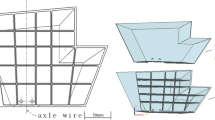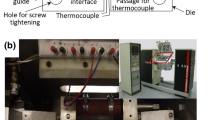Abstract
The variation of bonding ratio in the press bonding of TC4 alloy at temperatures from 850 to 900 °C, pressures from 10 to 30 MPa, and time from 5 to 15 min was investigated. The bonding ratio increases with the increase of temperature, time and pressure. The maximum bonding ratio, i.e. 98 %, can be obtained at 900 °C, 30 MPa and 15 min. The significance and interaction of bonding parameters with the bonding ratio were investigated. The results demonstrate that the effect of pressure on the bonding ratio is the most effective and the effect of temperature is secondary, while the effect of time is not very powerful. The interaction of bonding parameter on the bonding ratio exists but that is distinguishing in different bonding parameter ranges. It is concluded that increasing pressure can be considered as the primary method to increase the bonding ratio.






Similar content being viewed by others
References
Wu H. Influence of process variables on press bonding of superplastic 8090 Al–Li alloy. Mater Sci Eng A. 1999;264(1–2):194.
Kurt B, Eroglu M. Diffusion bonding between high chromium white iron and austenitic stainless steel. Sci Technol Weld Join. 2007;12(5):467.
Li H, Liu HB, Yu WX, Li MQ. Fabrication of high strength bond of Ti-17 alloy using press bonding under a high bonding pressure. Mater Lett. 2013;108:212.
Gόmez de Salazar JM, Ureña A, Carriόn JG. Charpy impact test of Ti–6Al–4V joints diffusion welded at low temperature. Scr Mater. 1996;35(4):479.
Zuruzi AS, Li H, Dong G. Effects of surface roughness on the diffusion bonding of Al alloy 6061 in air. Mater Sci Eng A. 1999;270(2):244.
Wang A, Ohashi O, Ueno K. Effect of surface asperity on diffusion bonding. Mater Trans. 2006;47(1):179.
Ravisankar B, Krishnamoorthi J, Ramakrishnan SS, Angelo PC. Diffusion bonding of SU 263. J Mater Process Technol. 2009;209(4):2135.
Wang XL, Zhao YQ, Hou HL, Wang YQ. Effect of hydrogen content on superplastic forming/diffusion bonding of TC21 alloys. J Alloy Compd. 2010;503(1):151.
Liu HJ, Feng XL. Microstructures and interfacial quality of diffusion bonded TC21 titanium alloy joints. Trans Nonferrous Met Soc China. 2011;21(1):58.
Gupta R, Shishodia KS, Sekhon GS. Optimization of grinding process parameters using enumeration method. J Mater Process Technol. 2001;115(1):122.
Xie KF, Zhou TR. Optimization with different methods for material processing parameters. J Mater Process Technol. 2007;187–188:706.
Kim SJ, Cho YG, Oh CS, Kim DE, Moon MB, Han HN. Development of a dual phase steel using orthogonal design method. Mater Design. 2009;30(4):1251.
Li Y, Li J, Zhang JY, Zhang YZ, Zhang T, Zhao Y. Performance of organosilicone heat resistant coating and its influencing factors. Chin J Rare Met. 2013;37(4):290.
Wu H, Lee S. Effect of bonding variables on bonding mechanisms in press bonding superplastic 8090 aluminum alloy. Mater Sci Technol. 2001;17(8):906.
Ma RF, Li MQ, Li H, Yu WX. Modeling of void closure in diffusion bonding process based on dynamic conditions. Sci China Technol Sci. 2012;55(9):2420.
Acknowledgments
This work was financially supported by the National Natural Science Foundation of China (No. 51275416).
Author information
Authors and Affiliations
Corresponding author
Rights and permissions
About this article
Cite this article
Li, H., Li, MQ., Yu, WX. et al. Significance and interaction of bonding parameters with bonding ratio in press bonding of TC4 alloy. Rare Met. 35, 235–241 (2016). https://doi.org/10.1007/s12598-014-0330-3
Received:
Revised:
Accepted:
Published:
Issue Date:
DOI: https://doi.org/10.1007/s12598-014-0330-3




